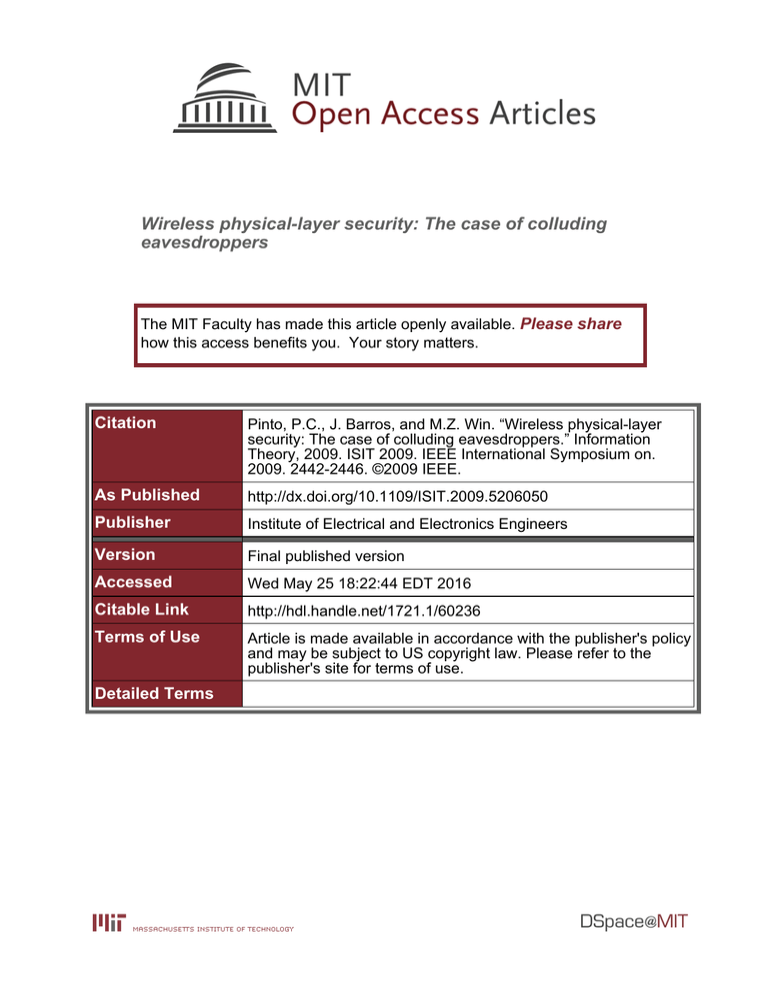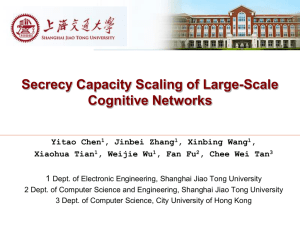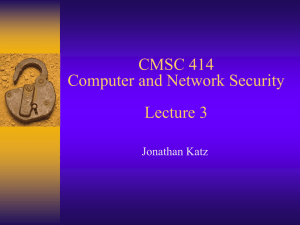Wireless physical-layer security: The case of colluding eavesdroppers Please share
advertisement

Wireless physical-layer security: The case of colluding
eavesdroppers
The MIT Faculty has made this article openly available. Please share
how this access benefits you. Your story matters.
Citation
Pinto, P.C., J. Barros, and M.Z. Win. “Wireless physical-layer
security: The case of colluding eavesdroppers.” Information
Theory, 2009. ISIT 2009. IEEE International Symposium on.
2009. 2442-2446. ©2009 IEEE.
As Published
http://dx.doi.org/10.1109/ISIT.2009.5206050
Publisher
Institute of Electrical and Electronics Engineers
Version
Final published version
Accessed
Wed May 25 18:22:44 EDT 2016
Citable Link
http://hdl.handle.net/1721.1/60236
Terms of Use
Article is made available in accordance with the publisher's policy
and may be subject to US copyright law. Please refer to the
publisher's site for terms of use.
Detailed Terms
ISIT 2009, Seoul, Korea, June 28 - July 3, 2009
Wireless Physical-Layer Security:
The Case of Colluding Eavesdroppers
Pedro C. Pinto, Student Member, IEEE, João Barros, Member, IEEE,
and Moe Z. Win, Fellow, IEEE
Abstract—We consider the fundamental security limits of
stochastic wireless networks in the presence of colluding eavesdroppers. By establishing a direct connection with the singleinput multiple-output (SIMO) Gaussian wiretap channel, we
are able to provide a complete characterization of the secrecy
capacity for the case in which the eavesdroppers are scattered
according to a spatial Poisson process. Our analysis, which
includes the probabilities of existence and outage of secrecy
capacity, helps clarify how the spatial density of eavesdroppers
can jeopardize the success of wireless physical-layer security
based on information-theoretic principles.
Index Terms—Information-theoretic security, wireless channels, secrecy capacity, colluding eavesdroppers, stochastic geometry.
I. I NTRODUCTION
Although much has been achieved in terms of securing
the higher layers of the classical protocol stack, protecting
the physical layer of wireless networks from one or multiple eavesdroppers remains a formidable task. Due to the
properties of the physical medium, any unauthorized receiver
located within the transmission range is capable of observing
the signals sent by the legitimate transmitters. Moreover, the
attacker is free to combine its own observations with those of
other eavesdroppers, thus improving its reception by means of
cooperative inference. On a more positive tone, recent results
in information theory indicate that the physical properties
of wireless channels, such as multipath fading, can be used
effectively to complement the levels of secrecy attained by
means of classical cryptographic primitives.
The theoretical foundation for physical-layer security over
noisy channels, which builds on the notion of perfect secrecy [1], was laid in [2] and later in [3]. More recently, spacetime signal processing techniques for secure communication
over wireless links appeared in [4], and the secrecy capacity of
various single-input multiple-output (SIMO) fading channels
was established in [5]. The concept of outage secrecy capacity
of slow fading channels was presented in detail in [6], whereas
the ergodic secrecy capacity of fading channels was derived
in [7], [8]. The presence of colluding eavesdroppers is considered in [9], but restricting its attention to a fixed number of
eavesdroppers placed at the same spatial location. The secrecy
P. C. Pinto and M. Z. Win are with the Laboratory for Information and Decision Systems (LIDS), Massachusetts Institute of Technology,
Room 32-D674, 77 Massachusetts Avenue, Cambridge, MA 02139, USA
(e-mail: ppinto@mit.edu, moewin@mit.edu).
J. Barros is with the Instituto de Telecomunicações, Departamento de
Engenharia Electrotécnica e de Computadores, Faculdade de Engenharia da
Universidade do Porto, Portugal (e-mail: jbarros@fe.up.pt).
978-1-4244-4313-0/09/$25.00 ©2009 IEEE
properties of stochastic wireless networks are discussed in
[10], [11], for the case of non-colluding eavesdroppers.
Intrigued by the fundamental limits of physical-layer security in wireless networks with multiple colluding eavesdroppers, we address the issue of how the spatial distribution of
the eavesdroppers and the propagation characteristics of the
channel ultimately determine the achievable secrecy rates. In
large-scale wireless networks, the spatial distribution of the
nodes can be modeled either deterministically or stochastically. Deterministic models include square, triangular, and
hexagonal lattices in the two-dimensional plane [12], [13],
which are applicable when the location of the nodes in the
network is known exactly or is constrained to a regular structure. However, in many ad-hoc scenarios, only a statistical
description of the location of the nodes is available, and thus
a stochastic spatial model should be employed. In particular,
the homogeneous Poisson point process [14] is a natural
model when all the points in a region are equally likely
possibilities for the location of a node. The Poisson process
has been successfully used in the context of wireless networks,
to analyze network interference [15], [16], connectivity and
coverage [17], [18], routing [19], and sensor cooperation [20],
among other topics.
The main contributions of this paper are as follows:
•
•
•
Secrecy capacity in the presence of colluding eavesdroppers: After establishing the equivalence between communication in the presence of colluding eavesdroppers
and the SIMO Gaussian wiretap channel, we obtain an
expression for the corresponding secrecy capacity, when
the eavesdroppers are scattered according to an arbitrary
spatial process.
Probabilistic characterization of the secrecy capacity:
For the case where the eavesdroppers are scattered according to a spatial Poisson process, we provide the
cumulative distribution function (c.d.f.) of the corresponding secrecy capacity.
Existence and outage of secrecy capacity: We present
expressions for the probabilities of existence and outage
of the secrecy capacity, in the presence of a Poisson field
of colluding eavesdroppers.
The remainder of the paper is organized as follows. Section II
describes the system model. Section III considers the secrecy
capacity for an arbitrary spatial process of eavesdroppers. Section IV characterizes the distribution of the secrecy capacity
when the eavesdroppers are spatially distributed according
to a Poisson process. Section V analyzes the corresponding
existence and outage of secrecy capacity. Section VI presents
2442
2
ISIT 2009, Seoul, Korea, June 28 - July 3, 2009
Main channel
Alice (probe transmitter)
hM
Bob (probe receiver)
wM
Colluding eavesdroppers
x
Γ1
yM
rM
yE
Γ3
hE
Γ2
wE
Wiretap channel
Figure 2. SIMO Gaussian wiretap channel, which can be used to analyze
the scenario of colluding eavesdroppers depicted in Fig. 1.
Figure 1.
Communication in the presence of colluding eavesdroppers.
a case study to illustrate the metrics derived in this paper, as
well as their dependence on network parameters such as the
transmitted power and the spatial density of eavesdroppers.
Section VII concludes the paper and summarizes important
findings.
II. S YSTEM M ODEL
We consider the scenario depicted in Fig. 1, where a main
link is composed of two nodes: one transmitter located at
the origin (Alice), and one receiver deterministically located
at a distance rM from the origin (Bob). The eavesdroppers
are scattered in the two-dimensional plane according to an
arbitrary spatial process ΠE . The distances of eavesdroppers
to the origin are denoted by {Γi }∞
i=1 , where Γ1 ≤ Γ2 ≤ . . .. In
addition, the eavesdroppers are allowed to collude, i.e., they
can exchange and combine the information received by all
the eavesdroppers, thus improving their ability to decode the
secret message.
To account for the propagation characteristics of the environment, we consider that the signal amplitude decays with
the distance r according to k/rb , for some given constant k.
The amplitude loss exponent b is environment-dependent,
and can approximately range from 0.8 (e.g., hallways inside
buildings) to 4 (e.g., dense urban environments), where b = 1
corresponds to free space propagation [21].1
Since the colluding eavesdroppers may gather the received
information and send it to a central processor, the scenario
depicted in Fig. 1 is equivalent to the SIMO Gaussian
wiretap channel depicted in Fig. 2. Here, the input is the
signal transmitted by Alice, and the output of the SIMO
wiretap channel is the collection of signals received by all the
eavesdroppers. We consider that Alice sends a symbol x ∈ C
with power constraint E{|x|2 } ≤ P . The vectors hM ∈ Cm
and hE ∈ Cn represent, respectively, the gains of the main
and eavesdropper channels.2 The noise is represented by the
1 Note that the amplitude loss exponent is b, while the corresponding power
loss exponent is 2b.
2 We use boldface letters to denote vectors and matrices.
vectors wM ∈ Cm and wE ∈ Cn , considered mutually
independent and Gaussian distributed with zero mean and
non-singular covariance matrices ΣM and ΣE , respectively.
The system of Fig. 2 can then be summarized as
!
yM = hM x + wM
(1)
yE = hE x + wE .
The general SIMO system in Fig. 2 reduces
to the scenario
"
#T
b
in Fig. 1 by setting hM = 1/rM
, hE = 1/Γb1 , 1/Γb2 , · · · ,
ΣM = WM I1 , and ΣE = WE I∞ , where WM and WE are the
noise powers of the legitimate and eavesdropper receivers,
respectively, and In is the n × n identity matrix.
III. S ECRECY C APACITY IN THE P RESENCE OF
C OLLUDING E AVESDROPPERS
In this section, we determine the secrecy capacity of the
legitimate link, in the presence of colluding eavesdroppers
scattered in the plane according to an arbitrary spatial process.
The result is given by following theorem.
Theorem 3.1: For a given realization of the arbitrary eavesdropper process ΠE , the secrecy capacity of the legitimate link
is given by
$
% &
%
!
$
PE
P
,0 ,
− log2 1 +
Cs = max log2 1 + 2b
WE
rM WM
(2)
in bits per complex dimension, where PE is the aggregate
power received by all the eavesdroppers,
PE =
∞
'
P
.
2b
Γ
i=1 i
(3)
Proof: Writing the maximum-a-posteriori rule for the
main channel in Fig. 2, it can be shown that a sufficient
statistic to estimate x from yM is y(M = h†M Σ−1
M yM , and
similarly for the eavesdroppers’ channel [22].3 Since sufficient
statistics preserve mutual information, we can equivalently
express (1) in terms of sufficient statistics, for the purpose of
determining the secrecy capacity. Thus, by left-multiplying
2443
3 We
use † to denote the conjugate transpose operator.
3
ISIT 2009, Seoul, Korea, June 28 - July 3, 2009
each side of the equations by the corresponding term h† Σ−1 ,
we obtain
)
y(M = (
hM x + w
(M
(
y(E = hE x + w
(E ,
where4
(
hM = h†M Σ−1
M hM
†
−1
(
hE = hE ΣE hE
w
(M ∼ Nc (0, (
hM )
w
(E ∼ Nc (0, (
hE ),
and w
(M is independent of w
(E . This (complex) scalar description corresponds to the Gaussian wiretap channel introduced
in [23]. If CM and CE denote the capacities of the main
and eavesdroppers channels, respectively, we know that the
secrecy capacity Cs of the main channel for some realization
of the channels hM and hE is given by
Cs = CM − CE
*
)
+
*
+ ,
(
h2E
− log2 1 +
P ,0
= max log2
(
hE
*
)
+ ,
1 + h†M Σ−1
M hM P
= max log2
,0 .
(4)
1 + h†E Σ−1
E hE P
"
#T
b
Setting hM = 1/rM
, hE = 1/Γb1 , 1/Γb2 , · · · , ΣM =
WM I1 , and ΣE = WE I∞ , (4) reduces to
%
$
% &
!
$
PE
P
− log2 1 +
,0 ,
Cs = max log2 1 + 2b
WE
rM WM
(5)
-∞
where PE = i=1 P/Γ2b
is
the
aggregate
power
received
by
i
all the eavesdroppers. This is the result in (2) and the proof
is concluded.
(
h2
1 + MP
(
hM
IV. P ROBABILISTIC C HARACTERIZATION OF THE
S ECRECY C APACITY
Theorem 3.1 is valid for an arbitrary spatial process ΠE ,
deterministic or stochastic. In the latter case, the secrecy
capacity Cs of the main link in (2) is a random variable
(r.v.), since it is a function the random eavesdropper distances
{Γi }∞
i=1 . In the rest of the paper, we analyze the case
where ΠE is a homogeneous Poisson process in the twodimensional plane. Typically, the eavesdropper positions are
unknown a priori, so we may as well treat them as completely
random according to a spatial Poisson process.5 Then, the
probability P{n in R} of n eavesdroppers being inside a
region R (not necessarily connected) depends only on the
total area A of the region, and is given by [14]
P{n in R} =
(λE A)n −λE A
e
,
n!
n ≥ 0,
4 We use N (0, σ 2 ) to denote a circularly symmetric (CS) complex Gausc
sian distribution, where the real and imaginary parts are i.i.d. N (0, σ2 /2).
5 The spatial Poisson process is a natural choice in such situation because,
given that a node is inside a region R, the probability density function (p.d.f.)
of its position is conditionally uniform over R.
where λE is the (constant) spatial density of eavesdroppers,
in nodes per unit area. The following theorem characterizes
the distribution of the secrecy capacity in this scenario.
Theorem 4.1: If ΠE is a Poisson process with density λE ,
the secrecy capacity Cs of the main channel is a r.v. whose
c.d.f. FCs (c) is given by
0,
„
c < 0,
«
−c
P
2 −1
1+ 2b
r WM
, 0 ≤ c < CM ,
FCs (c) = 1 − FPeE (πλMC −1
b P
)
E 1/b
WE
1,
c ≥ CM ,
(6)
7
6
P
where CM = log2 1 + r2b WM is the capacity of the main
M
channel; Cα is defined as
1−α
Cα !
(7)
Γ(2 − α) cos(πα/2)
with Γ(·) denoting the gamma function; and FPeE (·) is the
c.d.f of a stable r.v. P(E , with parameters6
%
$
1
(
(8)
PE ∼ S α = , β = 1, γ = 1 ,
b
and b > 1.
Proof: The secrecy capacity Cs of the main channel in
(2) is a function of the r.v. PE , and is therefore also random.
In [15], we show that the characteristic function of PE in (3)
has the form
8
6 πα 797
6
,
φPE (w) = exp −γ|w|α 1 − jβ sign(w) tan
2
(9)
where
1
−1 1/b
α = , β = 1, γ = πλE C1/b
P ,
(10)
b
and b > 1. R.v.’s with such characteristic function belong
to the class of skewed stable distributions [24]. Stable laws
are a direct generalization of Gaussian distributions, and
include other densities with heavier (algebraic) tails. They
share many properties with Gaussian distributions, namely the
stability property and the generalized central limit theorem.
Equations (9)-(10) can be succinctly expressed as
%
$
1
−1 1/b
.
(11)
PE ∼ S α = , β = 1, γ = πλE C1/b P
b
1
Defining the normalized stable r.v.: P(E ;= PE γ − α =
PE
1
, we have that P(E ∼ S b , 1, 1 from the scal(πλ C −1 )b P
E 1/b
ing property [24]. In general, the c.d.f. FPeE (·) cannot be
expressed in closed form except in the case where b = 2,
which is analyzed in Section VI. However, the characteristic function of P(E has the simple form of φPeE (w) =
:
"
: π ;#;
, and thus FPeE (·) can
exp −|w|1/b 1 − j sign(w) tan 2b
6 We use S(α, β,γ ) to denote the distribution of a real stable r.v.
with characteristic exponent α ∈ (0, 2], skewness β ∈ [−1, 1], and dispersion γ ∈ [0, ∞). The corresponding characteristic function is
(
`
ˆ
` ´˜´
, α $= 1,
exp −γ|w|α 1 − jβ sign(w) tan πα
2
`
ˆ
˜´
φ(w) =
2
exp −γ|w| 1 + j π β sign(w) ln |w| ,
α = 1.
2444
4
ISIT 2009, Seoul, Korea, June 28 - July 3, 2009
always be expressed in the integral form and computed
numerically.
Using (2), we can now express FCs (c) in terms of FPeE (·),
for 0 ≤ c < CM , as
FCs (c) = P{Cs ≤ c}
%
&
!
$
$
%
P
PE
≤c
= P log2 1 + 2b
− log2 1 +
WE
rM WM
<$
!
%
=&
P
= 1 − P PE ≤ WE 1 + 2b
2−c − 1
r W
7 M M
6
P
1 + r2b WM 2−c − 1
M
.
= 1 − FPeE
−1 b P
(πλE C1/b
) WE
In addition, FCs (c) = 0 for c < 0 and FCs (c) = 1 for
c ≥ CM , since the r.v. Cs in (2) satisfies 0 ≤ Cs ≤ CM ,
i.e., the secrecy capacity of the main link in the presence of
colluding eavesdroppers is a positive quantity which cannot
be greater that the secrecy capacity of the main link in the
absence of eavesdroppers. This is the result in (6) and the
proof is complete.
V. E XISTENCE AND O UTAGE OF S ECRECY C APACITY
Based on the results of Section IV, we now obtain the
probabilities of existence and outage of the secrecy capacity,
in the presence of a Poisson field of colluding eavesdroppers.
The following corollary provides such probabilities.
Corollary 5.1: If ΠE is a Poisson process with density λE ,
the probability of existence of a non-zero secrecy capacity,
pexist = P{Cs > 0}, is given by
*
+
WE
,
(12)
pexist = FPeE
2 C −1 )b W
(πλE rM
M
1/b
and the probability of an outage in secrecy capacity,
poutage (Rs ) = P{Cs < Rs } for some target secrecy rate Rs >
0, is given by
poutage (Rs ) =
(13)
„
«
−Rs
P
1+ 2b
2
−1
r WM
, 0 < Rs < CM ,
1 − FPeE (πλM C −1
P
b
E 1/b ) W
=
E
1,
Rs ≥ CM ,
6
7
where CM = log2 1 + r2bPWM is the capacity of the main
M
channel; and FPeE (·) is the c.d.f. of the normalized stable
r.v. P(E , with parameters given in (8).
Proof: The expressions for pexist and poutage (Rs ) follow
directly from (6).
VI. C ASE S TUDY
We now illustrate the results obtained in the previous
sections with a simple case study. We consider the case
where WM = WE = W , i.e., the main link and the
eavesdroppers are subject to the same noise power, introduced
by the electronics of the respective receivers. Furthermore,
we consider that the amplitude loss exponent is b = 2, in
(
which case the c.d.f. of
√ PE can be expressed in closed form
as FPeE (x) = erfc(1/ 2x), x ≥ 0. The c.d.f. of Cs in (6)
reduces to
FCs (c) =
(14)
0,
c < 0,
>
P
−1
W«
, 0 ≤ c < CM ,
„
= erf √π2 λE C1/2
1+ 4P
2−c −1
r W
M
1,
c ≥ CM .
In addition, (12) and (13) reduce, respectively, to
$
%
π
2 −1
pexist = erfc √ λE rM C1/2
2
and
(15)
poutage (Rs ) =
(16)
>
P
erf √π λ C −1 „
W«
, 0 < Rs < CM ,
E
1/2
2
P
=
2−Rs −1
1+ 4
r W
M
1,
Rs ≥ CM .
Figures 3 and 4 quantify, respectively, the c.d.f. and p.d.f.
of the secrecy capacity Cs of the main link, for the considered
case study. We observe that Cs is a positive quantity which
cannot be greater that the secrecy capacity CM of the main
link in the 6absence of eavesdroppers,
which in this case is
7
CM = log2 1 + r2bPWM = 3.46 bits per complex dimension.
M
Furthermore, as the eavesdropper density λE increases, the
probability mass of Cs becomes more concentrated around
zero, in the sense that smaller realizations of Cs become more
likely. Similarly, the impulses of the p.d.f. at the origin, given
by FCs (0)δ(c) (not represented in Fig. 4), also become larger
as λE increases.
Figure 5 quantifies the secrecy outage probability poutage
in (16) versus the eavesdropper density λE , for various values
of P/W . We observe that as λE increases, an outage in
secrecy capacity of the main link becomes more likely,
since there are more eavesdroppers that can exchange and
combine the information, thus improving their ability to
decode the secret message. Furthermore, we observe that as
P/W → ∞, poutage decreases
monotonically,
6
7 converging to
π
2 −1 Rs /2
√
the curve poutage = erf
λ r C 2
.
2 E M 1/2
VII. C ONCLUSION
We established the fundamental security limits when the
eavesdroppers are allowed to collude, by showing that this
scenario is equivalent to a SIMO Gaussian wiretap channel.
We derived the secrecy capacity of a legitimate link, considering that the positions of the illegitimate receivers follow an
arbitrary spatial process ΠE . Then, for the case where ΠE is
a spatial Poisson process, we characterized the distribution of
the secrecy capacity, as well as the corresponding probabilities
of existence and outage. Perhaps the most interesting insight
to be gained from our results is the exact quantification of
the impact of the eavesdropper density λE on the achievable
secrecy rates — even a modest number of scattered attackers
2445
5
ISIT 2009, Seoul, Korea, June 28 - July 3, 2009
1
1
0.9
0.9
0.8
0.8
0.7
0.7
0.6
0.6
P/W = 1.1
poutage
FCs (c)
P/W = 1.5
0.5
0.5
0.4
0.4
0.3
0.3
0.2
0
0
0.2
λE = 0.2 m−2
λE = 0.1 m−2
λE = 0.05 m−2
0.1
0.5
1
1.5
2
c (bits)
2.5
3
3.5
0.1
0
0
4
Figure 3. C.d.f. FCs (c) of the secrecy capacity Cs of the main link, for
various densities λE of eavesdroppers (b = 2, P/W = 10, rM = 1 m).
The vertical line marks the capacity of the main link, which for these system
parameters is CM = 3.46 bits/complex dimension.
1
0.9
0.8
λE = 0.2 m−2
λE = 0.1 m−2
λE = 0.05 m−2
0.7
fCs (c)
0.6
0.5
0.4
0.3
0.2
0.1
0
0
0.5
1
1.5
2
c (bits)
2.5
3
3.5
P/W = ∞
4
Figure 4. P.d.f. fCs (c) of the secrecy capacity Cs of the main link, for various eavesdropper densities λE (b = 2, P/W = 10, rM = 1 m). Note that
the Dirac impulses at the origin, given by FCs (0)δ(c), are not plotted in the
figure. For the chosen values of λE , we have FCs (0)|λE ={0.05,0.1,0.2} =
{0.1561, 0.3062, 0.5690}.
can dramatically reduce the levels of security that can be
provided at the physical layer of a wireless communication
network.
R EFERENCES
[1] C. E. Shannon, “Communication theory of secrecy systems,” Bell
System Technical Journal, vol. 29, pp. 656–715, 1949.
[2] A. D. Wyner, “The Wire-Tap Channel,” Bell System Technical Journal,
vol. 54, no. 8, pp. 1355–1367, October 1975.
[3] R. Ahlswede and I. Csiszar, “Common randomness in information
theory and cryptography - Part I: Secret sharing,” IEEE Trans. Inf.
Theory, vol. 39, no. 4, pp. 1121–1132, July 1993.
[4] A. Hero, “Secure space-time communication,” IEEE Transactions on
Information, vol. 49, no. 12, pp. 3235–3249, Dec. 2003.
[5] P. Parada and R. Blahut, “Secrecy capacity of SIMO and slow fading
channels,” in Proc. IEEE Int. Symp. on Inf. Theory, Adelaide, Australia,
Sept. 2005, pp. 2152–2155.
0.05
0.1
0.15
λE (m−2)
0.2
0.25
0.3
Figure 5.
Secrecy outage probability poutage versus the eavesdropper
density λE , for various values of P/W (b = 2, rM = 1 m, Rs = 1 bit).
[6] M. Bloch, J. Barros, M. R. D. Rodrigues, and S. W. McLaughlin,
“Wireless information-theoretic security,” IEEE Trans. Inf. Theory,
vol. 54, no. 6, pp. 2515–2534, 2008.
[7] Z. Li, R. Yates, and W. Trappe, “Secrecy capacity of independent
parallel channels,” Proc. Annu. Allerton Conf. Communication, Control
and Computing, pp. 841–848, Sept. 2006.
[8] P. Gopala, L. Lai, and H. El Gamal, “On the Secrecy Capacity of Fading
Channels,” arxiv preprint cs.IT/0610103, 2006.
[9] S. Goel and R. Negi, “Secret communication in presence of colluding
eavesdroppers,” in Proc. Military Commun. Conf., Oct. 2005, pp. 1501–
1506.
[10] P. C. Pinto, J. Barros, and M. Z. Win, “Physical-layer security in
stochastic wireless networks,” in Proc. IEEE Int. Conf. on Commun.
Systems, Guangzhou, CHINA, Nov. 2008, pp. 974–979.
[11] M. Haenggi, “The secrecy graph and some of its properties,” in Proc.
IEEE Int. Symp. on Inf. Theory, Toronto, Canada, July 2008.
[12] J. Silvester and L. Kleinrock, “On the capacity of multihop slotted
ALOHA networks with regular structure,” IEEE Trans. Commun.,
vol. 31, no. 8, pp. 974–982, Aug. 1983.
[13] R. Mathar and J. Mattfeldt, “On the distribution of cumulated interference power in Rayleigh fading channels,” Wireless Networks, vol. 1,
pp. 31–36, Feb. 1995.
[14] J. Kingman, Poisson Processes. Oxford University Press, 1993.
[15] P. C. Pinto and M. Z. Win, “Communication in a Poisson field of
interferers - Part I: Interference distribution and error probability,” IEEE
Trans. Wireless Commun., 2009, accepted pending revision.
[16] ——, “Communication in a Poisson field of interferers - Part II: Channel
capacity and interference spectrum,” IEEE Trans. Wireless Commun.,
2009, accepted pending revision.
[17] C. Bettstetter and C. Hartmann, “Connectivity of wireless multihop
networks in a shadow fading environment,” Wireless Networks, vol. 11,
no. 5, pp. 571–579, Sept. 2005.
[18] D. Miorandi and E. Altman, “Coverage and connectivity of ad hoc
networks in presence of channel randomness,” in Proc. IEEE Conf. on
Computer Commun., vol. 1, Mar. 2005, pp. 491–502.
[19] M. Haenggi and D. Puccinelli, “Routing in ad hoc networks: A case
for long hops,” IEEE Commun. Mag., vol. 43, no. 10, pp. 93–101, Oct.
2005.
[20] T. Q. S. Quek, D. Dardari, and M. Z. Win, “Energy efficiency of dense
wireless sensor networks: To cooperate or not to cooperate,” IEEE J.
Sel. Areas Commun., vol. 25, no. 2, pp. 459–470, Feb. 2007.
[21] A. Goldsmith, Wireless Communications. Cambridge University Press,
2005.
[22] D. Tse and P. Viswanath, Fundamentals of Wireless Communication.
Cambridge University Press, 2005.
[23] S. Leung-Yan-Cheong and M. Hellman, “The Gaussian wire-tap channel,” IEEE Trans. Inf. Theory, vol. 24, no. 4, pp. 451–456, July 1978.
[24] G. Samoradnitsky and M. Taqqu, Stable Non-Gaussian Random Processes. Chapman and Hall, 1994.
2446









